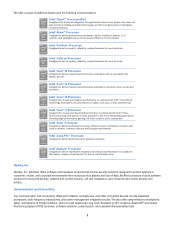Intel 2014 Annual Report Download - page 19
Download and view the complete annual report
Please find page 19 of the 2014 Intel annual report below. You can navigate through the pages in the report by either clicking on the pages listed below, or by using the keyword search tool below to find specific information within the annual report.We have obtained patents in the U.S. and other countries. Because of the fast pace of innovation and product development, and
the comparative pace of governments’ patenting processes, our products are often obsolete before the patents related to them
expire; in some cases, our products may be obsolete before the patents related to them are granted. As we expand our products
into new industries, we also seek to extend our patent development efforts to patent such products. In addition to developing
patents based on our own R&D efforts, we purchase patents from third parties to supplement our patent portfolio. Established
competitors in existing and new industries, as well as companies that purchase and enforce patents and other IP, may already
have patents covering similar products. There is no assurance that we will be able to obtain patents covering our own products, or
that we will be able to obtain licenses from other companies on favorable terms or at all.
The software that we distribute, including software embedded in our component-level and platform products, is entitled to
copyright and other IP protection. To distinguish our products from our competitors’ products, we have obtained trademarks and
trade names for our products, and we maintain cooperative advertising programs with customers to promote our brands and to
identify products containing genuine Intel components. We also protect details about our processes, products, and strategies as
trade secrets, keeping confidential the information that we believe provides us with a competitive advantage.
Compliance with Environmental, Health, and Safety Regulations
Our compliance efforts focus on monitoring regulatory and resource trends and setting company-wide performance targets for key
resources and emissions. These targets address several parameters, including product design; chemical, energy, and water use;
waste recycling; the source of certain minerals used in our products; climate change; and emissions.
As a company, we focus on reducing natural resource use, the solid and chemical waste by-products of our manufacturing
processes, and the environmental impact of our products. We currently use a variety of materials in our manufacturing process
that have the potential to adversely impact the environment and are subject to a variety of environmental, health, and safety
(EHS) laws and regulations. Over the past several years, we have significantly reduced the use of lead and halogenated flame
retardants in our products and manufacturing processes.
We work with the U.S. Environmental Protection Agency (EPA), non-governmental organizations (NGOs), OEMs, and retailers to
help manage e-waste (including electronic products nearing the end of their useful lives) and to promote recycling. The European
Union requires producers of certain electrical and electronic equipment to develop programs that let consumers return products
for recycling. Many U.S. states and countries in Latin America and Asia also have or are developing similar e-waste take-back
laws. Although these laws are typically targeted at the end electronic product and not the component products that we
manufacture, the inconsistency of many e-waste take-back laws and the lack of local e-waste management options in many areas
pose a challenge for our compliance efforts.
We are an industry leader in our efforts to build ethical sourcing of minerals for our products, including “conflict minerals” from the
Democratic Republic of the Congo (DRC) and adjoining countries. In 2013, we accomplished our goal to manufacture
microprocessors that are DRC conflict-free for tantalum, tin, tungsten, and gold. We continue our work to establish DRC conflict-
free supply chains for our company and our industry, and have set a new goal that all products currently on our roadmap for 2016
and beyond will be DRC conflict-free for these four minerals.
We seek to reduce our global greenhouse gas emissions by investing in energy conservation projects in our factories and working
with suppliers to improve energy efficiency. We take a holistic approach to power management, addressing the challenge at the
silicon, package, circuit, microarchitecture, macroarchitecture, platform, and software levels. We recognize that climate change
may cause general economic risk. For further information on the risks of climate change, see “Risk Factors” in Part I, Item 1A of
this Form 10-K. We see a potential for higher energy costs driven by climate change regulations. This could include items applied
to utility companies that are passed along to customers, such as carbon taxes or costs associated with obtaining permits for our
manufacturing operations, emission cap and trade programs, or renewable portfolio standards.
We are committed to sustainability and take a leadership position in promoting voluntary environmental initiatives and working
proactively with governments, environmental groups, and industry to promote global environmental sustainability. We believe that
technology will be fundamental to finding solutions to the world’s environmental challenges, and we are joining forces with
industry, business, and governments to find and promote ways that technology can be used as a tool to combat climate change.
We have been purchasing renewable energy at some of our major sites for several years. We purchase renewable energy
certificates under a multi-year contract. This purchase has placed Intel at the top of the EPA’s Green Power Partnership for the
past seven years and is intended to help stimulate the market for green power, leading to additional generating capacity and,
ultimately, lower costs.
14
























